fuel pressure FORD MUSTANG 2000 4.G Owners Manual
[x] Cancel search | Manufacturer: FORD, Model Year: 2000, Model line: MUSTANG, Model: FORD MUSTANG 2000 4.GPages: 224, PDF Size: 1.86 MB
Page 98 of 224
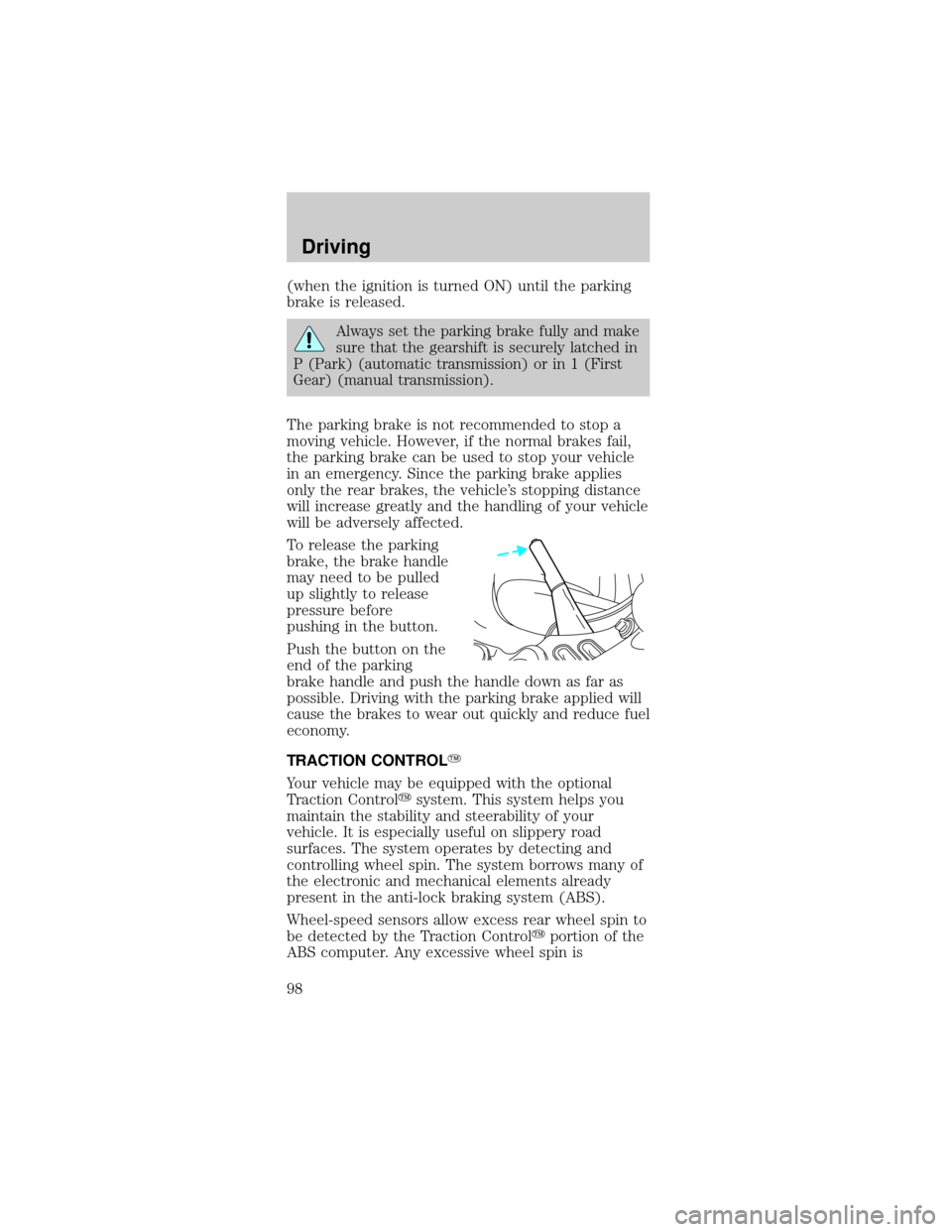
(when the ignition is turned ON) until the parking
brake is released.
Always set the parking brake fully and make
sure that the gearshift is securely latched in
P (Park) (automatic transmission) or in 1 (First
Gear) (manual transmission).
The parking brake is not recommended to stop a
moving vehicle. However, if the normal brakes fail,
the parking brake can be used to stop your vehicle
in an emergency. Since the parking brake applies
only the rear brakes, the vehicle's stopping distance
will increase greatly and the handling of your vehicle
will be adversely affected.
To release the parking
brake, the brake handle
may need to be pulled
up slightly to release
pressure before
pushing in the button.
Push the button on the
end of the parking
brake handle and push the handle down as far as
possible. Driving with the parking brake applied will
cause the brakes to wear out quickly and reduce fuel
economy.
TRACTION CONTROLY
Your vehicle may be equipped with the optional
Traction Controlysystem. This system helps you
maintain the stability and steerability of your
vehicle. It is especially useful on slippery road
surfaces. The system operates by detecting and
controlling wheel spin. The system borrows many of
the electronic and mechanical elements already
present in the anti-lock braking system (ABS).
Wheel-speed sensors allow excess rear wheel spin to
be detected by the Traction Controlyportion of the
ABS computer. Any excessive wheel spin is
Driving
98
Page 123 of 224
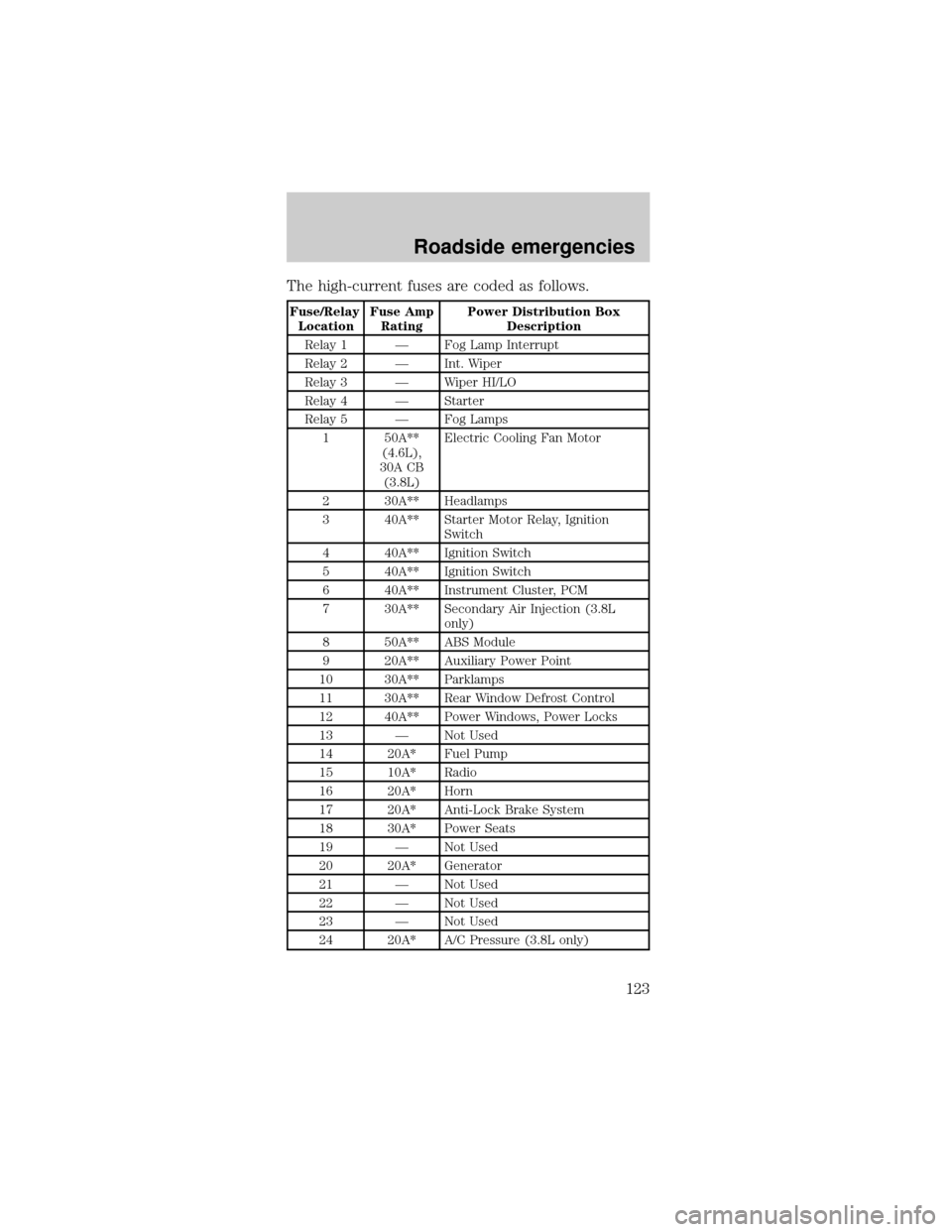
The high-current fuses are coded as follows.
Fuse/Relay
LocationFuse Amp
RatingPower Distribution Box
Description
Relay 1 Ð Fog Lamp Interrupt
Relay 2 Ð Int. Wiper
Relay 3 Ð Wiper HI/LO
Relay 4 Ð Starter
Relay 5 Ð Fog Lamps
1 50A**
(4.6L),
30A CB
(3.8L)Electric Cooling Fan Motor
2 30A** Headlamps
3 40A** Starter Motor Relay, Ignition
Switch
4 40A** Ignition Switch
5 40A** Ignition Switch
6 40A** Instrument Cluster, PCM
7 30A** Secondary Air Injection (3.8L
only)
8 50A** ABS Module
9 20A** Auxiliary Power Point
10 30A** Parklamps
11 30A** Rear Window Defrost Control
12 40A** Power Windows, Power Locks
13 Ð Not Used
14 20A* Fuel Pump
15 10A* Radio
16 20A* Horn
17 20A* Anti-Lock Brake System
18 30A* Power Seats
19 Ð Not Used
20 20A* Generator
21 Ð Not Used
22 Ð Not Used
23 Ð Not Used
24 20A* A/C Pressure (3.8L only)
Roadside emergencies
123
Page 158 of 224
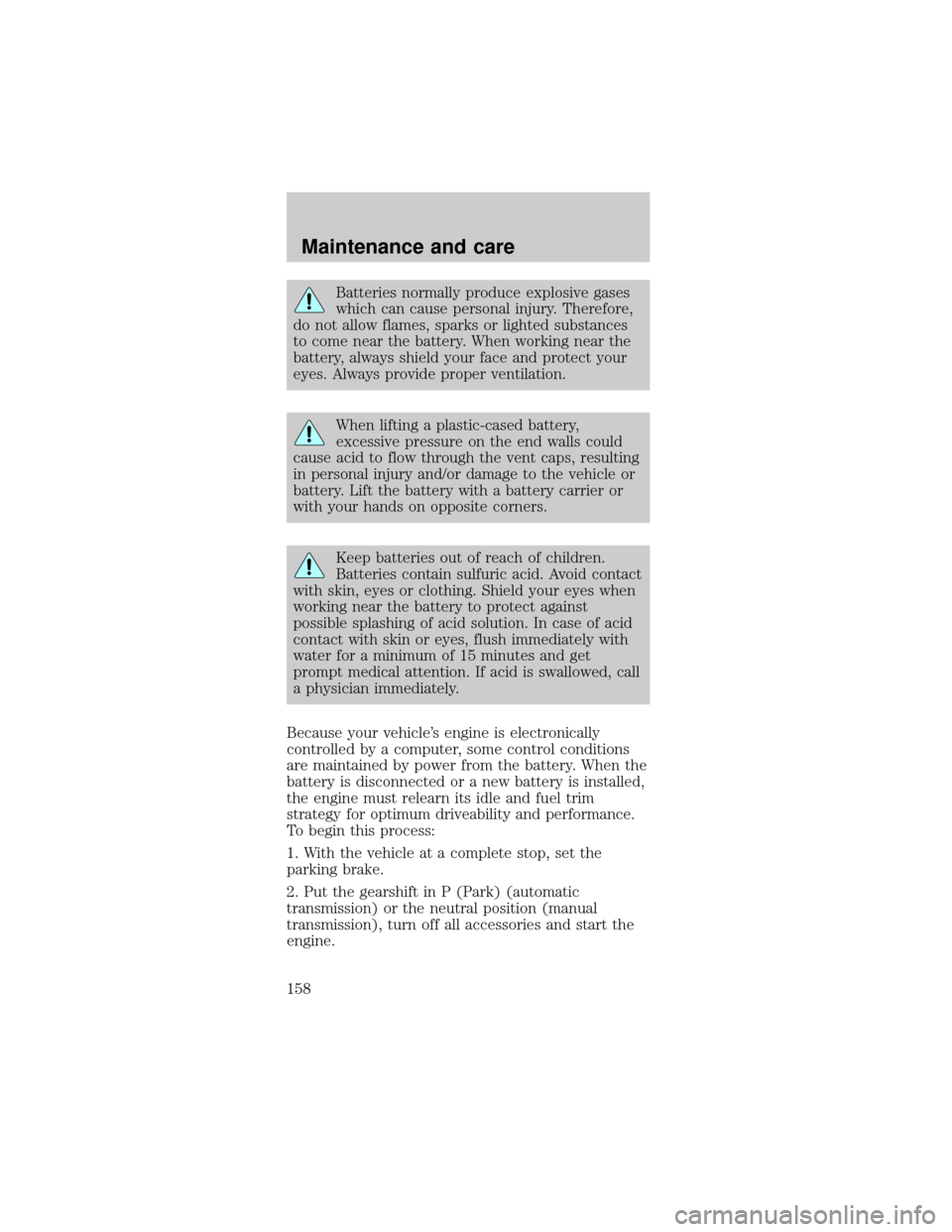
Batteries normally produce explosive gases
which can cause personal injury. Therefore,
do not allow flames, sparks or lighted substances
to come near the battery. When working near the
battery, always shield your face and protect your
eyes. Always provide proper ventilation.
When lifting a plastic-cased battery,
excessive pressure on the end walls could
cause acid to flow through the vent caps, resulting
in personal injury and/or damage to the vehicle or
battery. Lift the battery with a battery carrier or
with your hands on opposite corners.
Keep batteries out of reach of children.
Batteries contain sulfuric acid. Avoid contact
with skin, eyes or clothing. Shield your eyes when
working near the battery to protect against
possible splashing of acid solution. In case of acid
contact with skin or eyes, flush immediately with
water for a minimum of 15 minutes and get
prompt medical attention. If acid is swallowed, call
a physician immediately.
Because your vehicle's engine is electronically
controlled by a computer, some control conditions
are maintained by power from the battery. When the
battery is disconnected or a new battery is installed,
the engine must relearn its idle and fuel trim
strategy for optimum driveability and performance.
To begin this process:
1. With the vehicle at a complete stop, set the
parking brake.
2. Put the gearshift in P (Park) (automatic
transmission) or the neutral position (manual
transmission), turn off all accessories and start the
engine.
Maintenance and care
158
Page 165 of 224
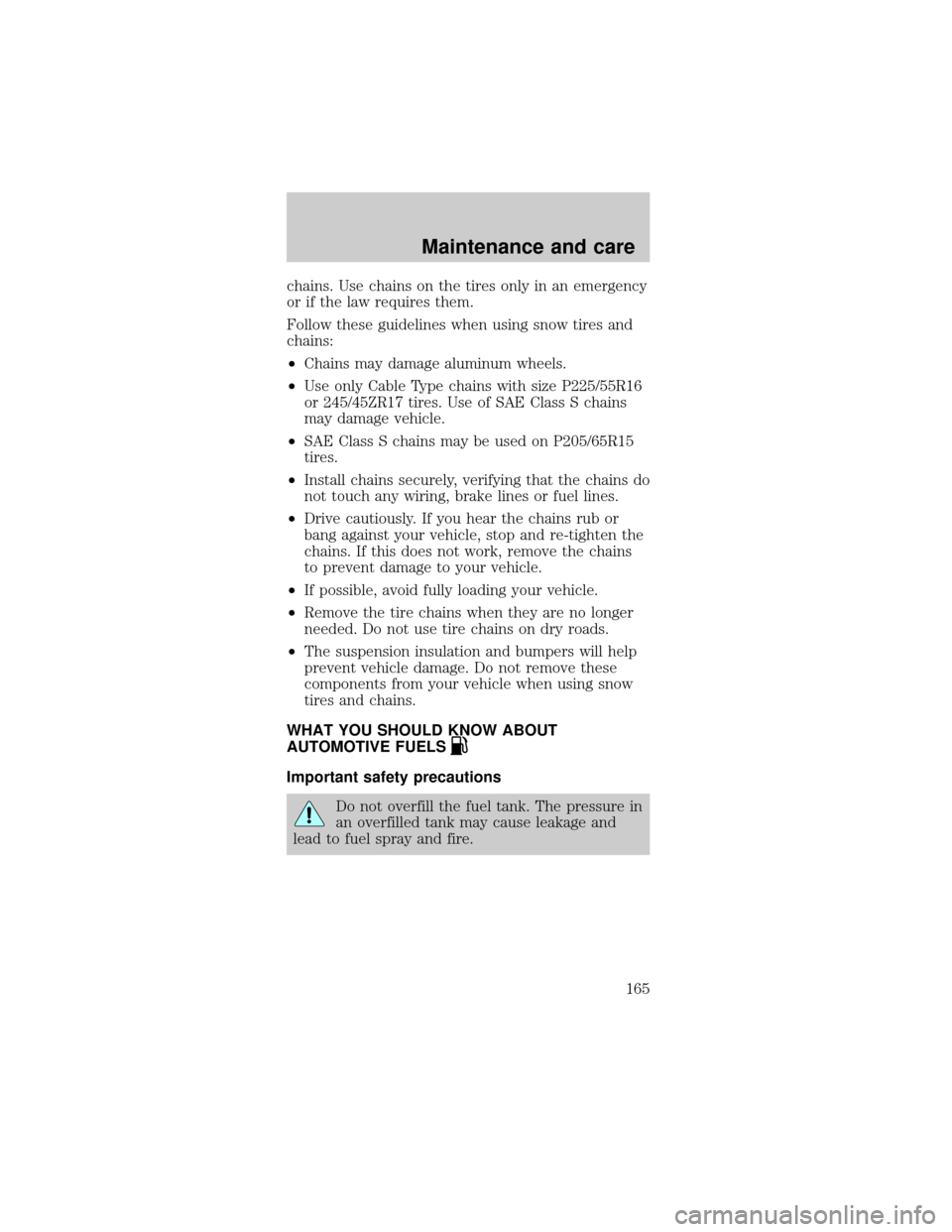
chains. Use chains on the tires only in an emergency
or if the law requires them.
Follow these guidelines when using snow tires and
chains:
²Chains may damage aluminum wheels.
²Use only Cable Type chains with size P225/55R16
or 245/45ZR17 tires. Use of SAE Class S chains
may damage vehicle.
²SAE Class S chains may be used on P205/65R15
tires.
²Install chains securely, verifying that the chains do
not touch any wiring, brake lines or fuel lines.
²Drive cautiously. If you hear the chains rub or
bang against your vehicle, stop and re-tighten the
chains. If this does not work, remove the chains
to prevent damage to your vehicle.
²If possible, avoid fully loading your vehicle.
²Remove the tire chains when they are no longer
needed. Do not use tire chains on dry roads.
²The suspension insulation and bumpers will help
prevent vehicle damage. Do not remove these
components from your vehicle when using snow
tires and chains.
WHAT YOU SHOULD KNOW ABOUT
AUTOMOTIVE FUELS
Important safety precautions
Do not overfill the fuel tank. The pressure in
an overfilled tank may cause leakage and
lead to fuel spray and fire.
Maintenance and care
165
Page 166 of 224
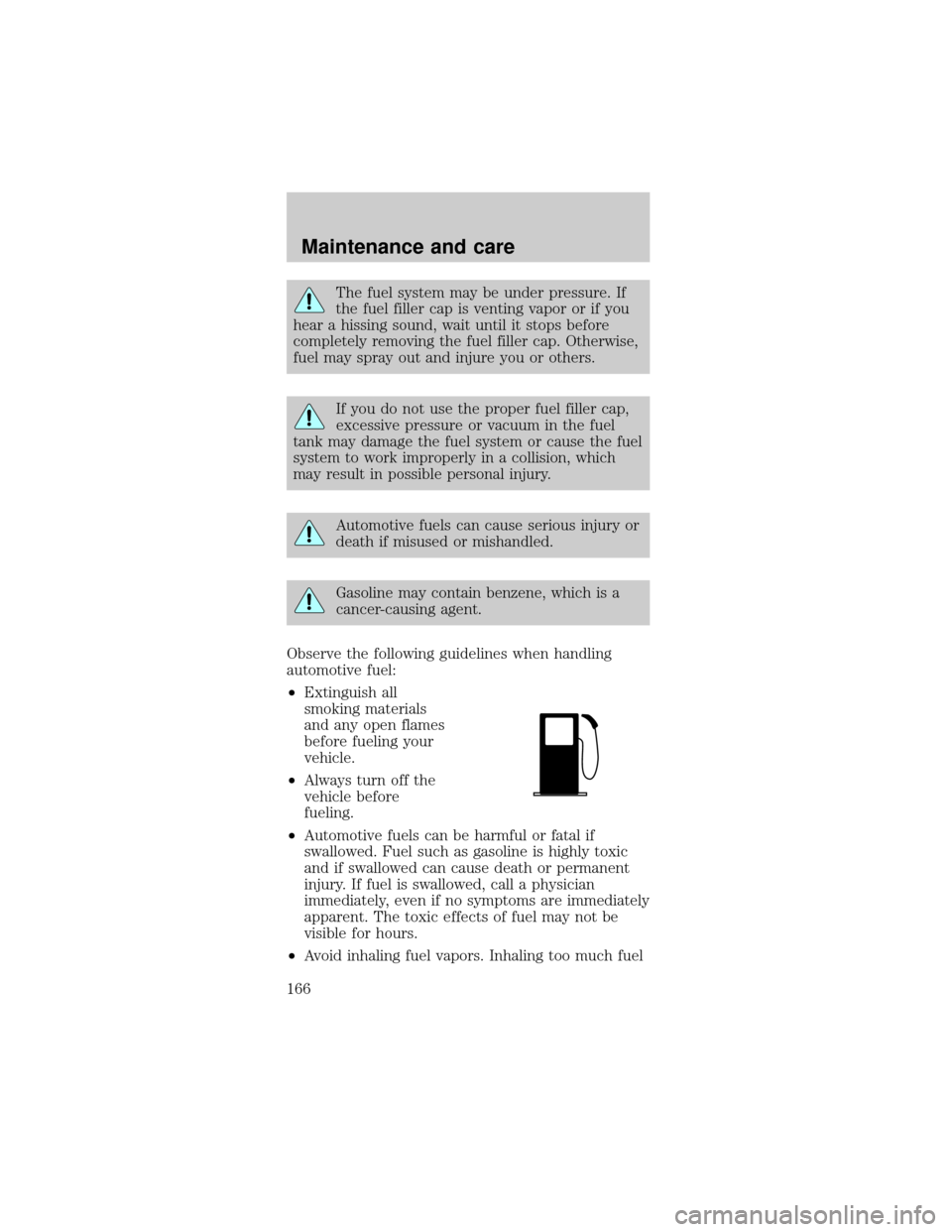
The fuel system may be under pressure. If
the fuel filler cap is venting vapor or if you
hear a hissing sound, wait until it stops before
completely removing the fuel filler cap. Otherwise,
fuel may spray out and injure you or others.
If you do not use the proper fuel filler cap,
excessive pressure or vacuum in the fuel
tank may damage the fuel system or cause the fuel
system to work improperly in a collision, which
may result in possible personal injury.
Automotive fuels can cause serious injury or
death if misused or mishandled.
Gasoline may contain benzene, which is a
cancer-causing agent.
Observe the following guidelines when handling
automotive fuel:
²Extinguish all
smoking materials
and any open flames
before fueling your
vehicle.
²Always turn off the
vehicle before
fueling.
²Automotive fuels can be harmful or fatal if
swallowed. Fuel such as gasoline is highly toxic
and if swallowed can cause death or permanent
injury. If fuel is swallowed, call a physician
immediately, even if no symptoms are immediately
apparent. The toxic effects of fuel may not be
visible for hours.
²Avoid inhaling fuel vapors. Inhaling too much fuel
Maintenance and care
166
Page 169 of 224
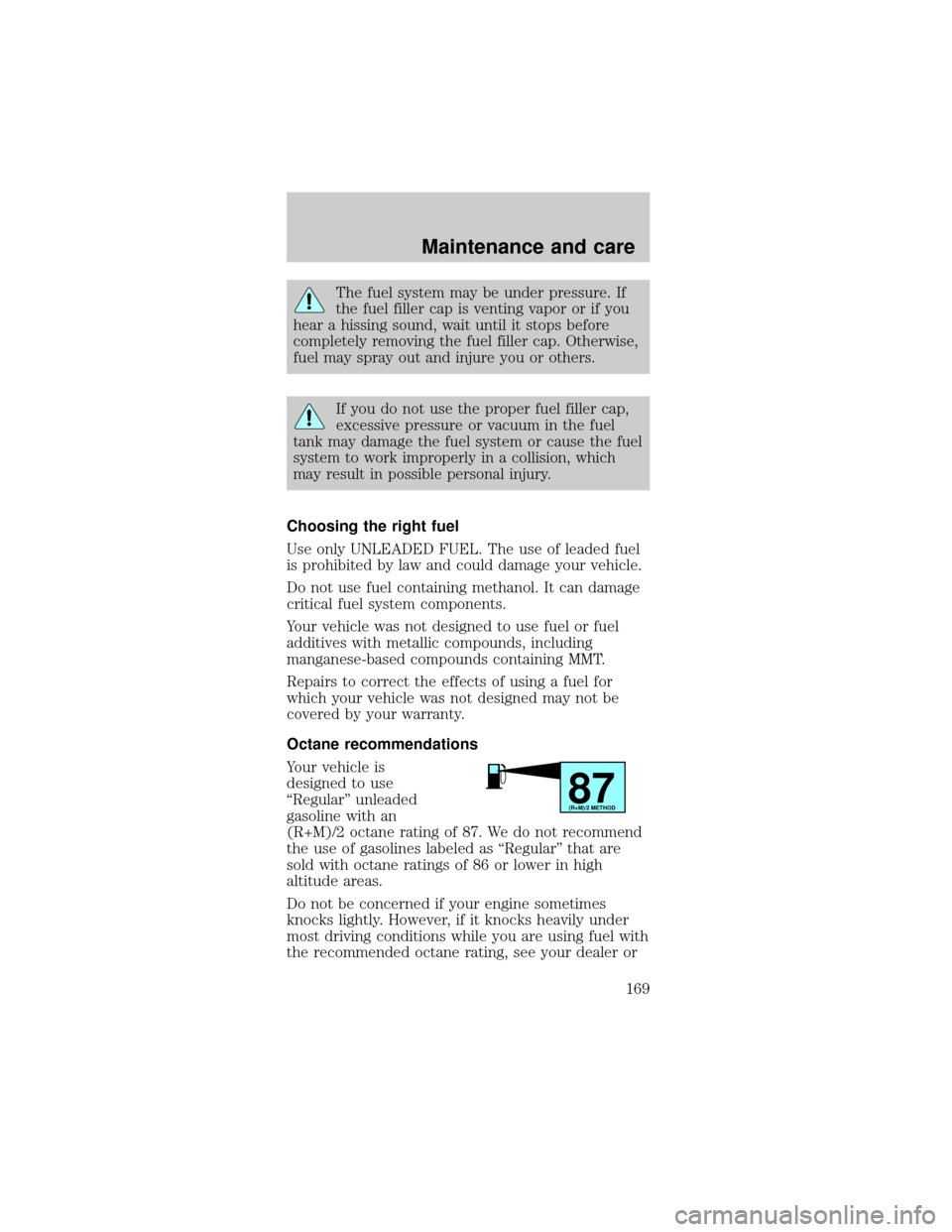
The fuel system may be under pressure. If
the fuel filler cap is venting vapor or if you
hear a hissing sound, wait until it stops before
completely removing the fuel filler cap. Otherwise,
fuel may spray out and injure you or others.
If you do not use the proper fuel filler cap,
excessive pressure or vacuum in the fuel
tank may damage the fuel system or cause the fuel
system to work improperly in a collision, which
may result in possible personal injury.
Choosing the right fuel
Use only UNLEADED FUEL. The use of leaded fuel
is prohibited by law and could damage your vehicle.
Do not use fuel containing methanol. It can damage
critical fuel system components.
Your vehicle was not designed to use fuel or fuel
additives with metallic compounds, including
manganese-based compounds containing MMT.
Repairs to correct the effects of using a fuel for
which your vehicle was not designed may not be
covered by your warranty.
Octane recommendations
Your vehicle is
designed to use
ªRegularº unleaded
gasoline with an
(R+M)/2 octane rating of 87. We do not recommend
the use of gasolines labeled as ªRegularº that are
sold with octane ratings of 86 or lower in high
altitude areas.
Do not be concerned if your engine sometimes
knocks lightly. However, if it knocks heavily under
most driving conditions while you are using fuel with
the recommended octane rating, see your dealer or
87(R+M)/2 METHOD
Maintenance and care
169
Page 175 of 224

²Using fuel blended with alcohol may lower fuel
economy.
²Fuel economy may decrease with lower
temperatures during the first 12±16 km (8±10
miles) of driving.
²Driving on flat terrain offers improved fuel
economy as compared to driving on hilly terrain.
²Transmissions give their best fuel economy when
operated in the top cruise gear and with steady
pressure on the gas pedal.
²Close windows for high speed driving.
EPA window sticker
Every new vehicle should have the EPA window
sticker. Contact your dealer if the window sticker is
not supplied with your vehicle. The EPA window
sticker should be your guide for the fuel economy
comparisons with other vehicles.
It is important to note the box in the lower left
corner of the window sticker. These numbers
represent the Range of L/100 km (MPG) expected
on the vehicle under optimum conditions. Your fuel
economy may vary depending upon the method of
operation and conditions.
EMISSION CONTROL SYSTEM
Your vehicle is equipped with various emission
control components and a catalytic converter which
will enable your vehicle to comply with applicable
exhaust emission standards. To make sure that the
catalytic converter and other emission control
components continue to work properly:
²Use only the specified fuel listed.
²Avoid running out of fuel.
²Do not turn off the ignition while your vehicle is
moving, especially at high speeds.
Maintenance and care
175
Page 187 of 224

Cleaning the wiper blades, windshield and rear
window
If the wiper blades do not wipe properly, clean the
wiper blade rubber element with undiluted
windshield washer solution or a mild detergent. To
avoid damaging the blades, do not use fuel,
kerosene, paint thinner or other solvents.
If the wiper still does not wipe properly, this could
be caused by substances on the windshield or rear
window such as tree sap and some hot wax
treatments used by commercial car washes. Clean
the outside of the windshield or rear window with a
non-abrasive cleaner such as Ford Ultra-Clear Spray
Glass Cleaner, (E4AZ-19C507±AA), available from
your Ford Dealer.Do notuse abrasive cleansers on
glass as they may cause scratches. The windshield or
rear window is clean if beads do not form when you
rinse it with water. The windshield, rear window and
wiper blades should be cleaned on a regular basis,
and blades or rubber elements replaced when worn.
Convertible top and padded molding care
To avoid damage to the vinyl top and moldings, use
only an approved Ford cleaner, or equivalent. Do not
use stiff bristle brushes or abrasive materials or
cleaners.
Hot waxes applied by commercial car washes can
affect the cleanability of vinyl material.
Using high water pressure or wand-type car washes
against the convertible top and windows may cause
water leaks and possible seal damage.
Cleaning the engine
Engines are more efficient when they are clean
because grease and dirt buildup keep the engine
warmer than normal. When washing:
²Take care when using a power washer to clean
the engine. The high pressure fluid could
penetrate the sealed parts and cause damage.
Maintenance and care
187
Page 214 of 224

Doors
lubricant
specifications ........ 193
Driving under special
conditions
through water ....... 115
Emergencies, roadside
jump-starting ........ 128
Emission
control system ......... 175
Engine ...................... 194
check engine/service
engine soon light ...... 9
cleaning ................. 187
coolant ................... 143
idle speed
control ................... 157
lubrication
specifications.. 193,194
refill capacities ...... 191
service points.. 136,137
starting after a
collision ................. 117
Engine block heater... 93
Engine oil ................ 137
checking
and adding ............ 137
dipstick .................. 137
filter,
specifications.. 140,191
recommendations... 140
refill capacities ...... 191
specifications.. 193,194
Exhaust fumes .......... 93
Floor mats ................. 53
Fluid capacities ....... 191
Foglamps ................... 48
Fuel .......................... 165
calculating fuel
economy ................ 171
cap ......................... 168
capacity ................. 191choosing
the right fuel ......... 169
comparisons with
EPA fuel economy
estimates ............... 175
detergent in fuel ... 170
filling your vehicle
with fuel .. 165,168,171
filter,
specifications.. 171,191
fuel pump shut-off
switch .................... 117
gauge ....................... 14
improving fuel
economy ................ 171
low fuel
warning light ........... 11
octane rating .. 169,194
quality .................... 170
running
out of fuel ............. 170
safety information
relating to
automotive fuels ... 165
Fuses ................. 118,119
Gas cap
(see Fuel cap) ......... 168
Gas mileage (see
Fuel economy) ........ 171
Gauges .................. 13,14
battery
voltage gauge .......... 16
engine coolant
temperature
gauge ....................... 14
engine oil
pressure gauge ....... 17
fuel gauge ................ 14
odometer ................. 15
speedometer ........... 15
tachometer .............. 15
trip odometer .......... 16
Index
214
Page 223 of 224
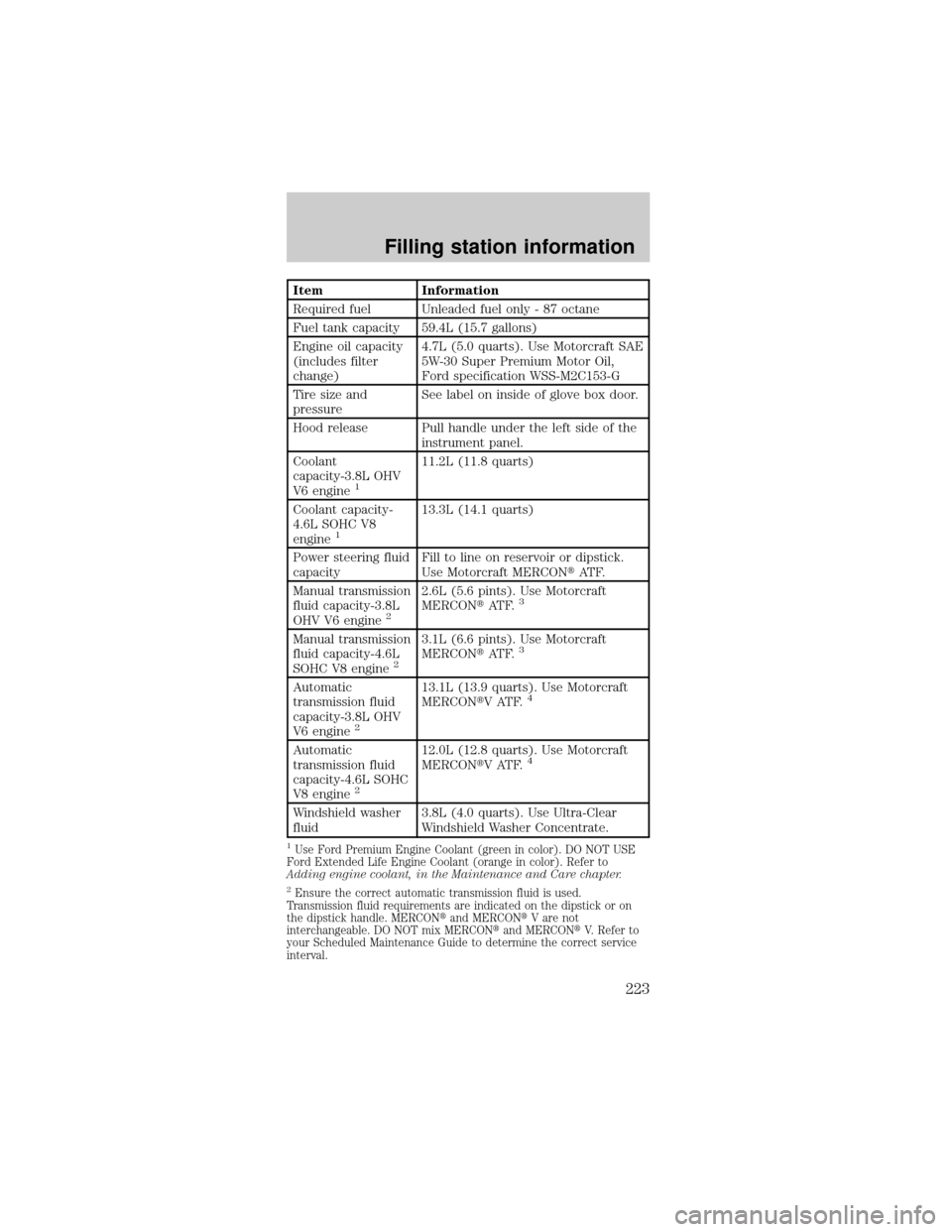
Item Information
Required fuel Unleaded fuel only - 87 octane
Fuel tank capacity 59.4L (15.7 gallons)
Engine oil capacity
(includes filter
change)4.7L (5.0 quarts). Use Motorcraft SAE
5W-30 Super Premium Motor Oil,
Ford specification WSS-M2C153-G
Tire size and
pressureSee label on inside of glove box door.
Hood release Pull handle under the left side of the
instrument panel.
Coolant
capacity-3.8L OHV
V6 engine
1
11.2L (11.8 quarts)
Coolant capacity-
4.6L SOHC V8
engine
1
13.3L (14.1 quarts)
Power steering fluid
capacityFill to line on reservoir or dipstick.
Use Motorcraft MERCONtAT F.
Manual transmission
fluid capacity-3.8L
OHV V6 engine
2
2.6L (5.6 pints). Use Motorcraft
MERCONtAT F.3
Manual transmission
fluid capacity-4.6L
SOHC V8 engine
2
3.1L (6.6 pints). Use Motorcraft
MERCONtAT F.3
Automatic
transmission fluid
capacity-3.8L OHV
V6 engine
2
13.1L (13.9 quarts). Use Motorcraft
MERCONtV ATF.4
Automatic
transmission fluid
capacity-4.6L SOHC
V8 engine
2
12.0L (12.8 quarts). Use Motorcraft
MERCONtV ATF.4
Windshield washer
fluid3.8L (4.0 quarts). Use Ultra-Clear
Windshield Washer Concentrate.
1Use Ford Premium Engine Coolant (green in color). DO NOT USE
Ford Extended Life Engine Coolant (orange in color). Refer to
Adding engine coolant, in the Maintenance and Care chapter.
2Ensure the correct automatic transmission fluid is used.
Transmission fluid requirements are indicated on the dipstick or on
the dipstick handle. MERCONtand MERCONtV are not
interchangeable. DO NOT mix MERCONtand MERCONtV. Refer to
your Scheduled Maintenance Guide to determine the correct service
interval.
Filling station information
223